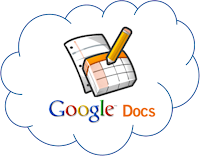The cloud isn't a scary place up in the sky that's untouchable. In my mind, it's one of the most exciting things that's ever happened in educational technology. I'll explain what it means for education, but first let me explain what the cloud is and how it's changing.
While the exact origin of the term is still up for debate, the cloud is thought to refer to classic network flowcharts in which the Internet was represented by a cloud. So, when people talk about the cloud, they're really just talking about the Internet.
The cloud has been used for off-site file storage for a long time. If you've ever used a browser-based email like Gmail, Yahoo! Mail, or Hotmail, or stored pictures at a website like Picasa Web, Flickr, or Photobucket, then you've used the cloud. What makes those cloud services? Your email, attachments, and pictures aren't stored on your computer, they're stored on the servers of those websites, on the Internet, in the cloud.
What's exciting about the cloud right now is that it's moving far beyond online file storage and into online applications. These are "programs" that run completely inside the web browser. There's nothing to download, nothing to install, and most of them are FREE.
More and more of these cloud applications crop up every day. Here's a short list of some of my favorite cloud-based applications:
Google Docs - Online office suite offering document creation, storage, and collaboration
Picnik - Easy to use, basic image editor. (The Teach the Cloud logo was created in Picnik)
Aviary - More advanced image editing, vector graphics, and music editing
JayCut - Video editing
Now, what does this mean for education? As I said, most cloud applications are FREE. So, instead of paying for site licenses for Microsoft Office, Photoshop, and Adobe Premiere, the main functions of those programs can be accessed for free through the cloud. With programs such as Google Apps, email functionality can be sent to the cloud, eliminating the need to keep Microsoft Exchange servers on site and avoiding licensing fees and upkeep costs. With all of the money that can be saved, I envision more and more school systems and teachers moving away from traditional software and into the cloud.
It's not just money, though. Many of these cloud-based applications also present more opportunities for teachers and students to collaborate. Applications like bubbl.us let students and teachers work together on interactive, online graphic organizers. Google Docs allows students to work on collaborative documents and presentations in small groups or class projects with each student at his/her own computer. In applications like Edmodo, the teacher can interact with students in an online classroom much like the social networks that today's students know so well.
Still, with all of the great things offered by cloud computing, is it a viable replacement for installed software? I would argue that it is. I haven't had a version of Microsoft Office installed on my personal computer in two years, instead relying on Google Docs as my main office suite. More recently I've moved away from software like Photoshop and G.I.M.P. and into the cloud with Picnik and Aviary. As the cloud becomes more prominent, I look forward to more advanced applications moving off of traditional software and into the cloud. Soon, the web browser will be the single most important program on a computer, if it's not already.
So, what do you think? Is the cloud the next step in educational technology, or is it just a passing fad? How do you think it will help shift education as we move forward? Add your comments and discuss at http://www.teachthecloud.com!
Comment
© 2025 Created by Steve Hargadon.
Powered by
![]()



You need to be a member of Classroom 2.0 to add comments!
Join Classroom 2.0